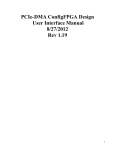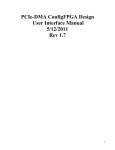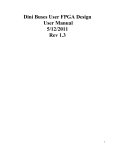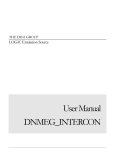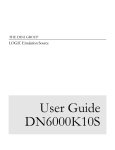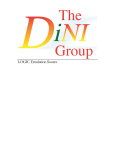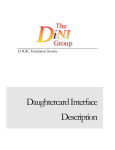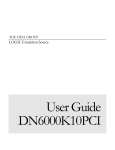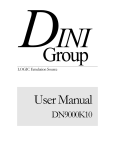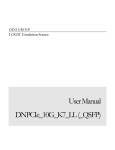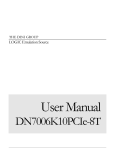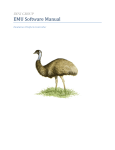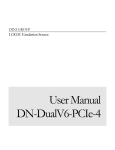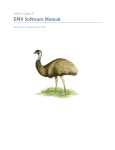Download PCIe-DMA ConfigFPGA Design User Interface Manual 8/7/2013 Rev
Transcript
PCIe-DMA ConfigFPGA Design User Interface Manual 8/7/2013 Rev 1.20 1 Table of Contents 1 2 3 4 5 6 7 Overview ............................................................................................................................................. 5 1.1 Purpose........................................................................................................................................ 5 1.2 Board Architecture overview ...................................................................................................... 5 1.2.1 ConfigFPGA PCIe Interface ................................................................................................... 5 1.2.2 ConfigFPGA FPGA Interface ................................................................................................. 6 Board Addressing................................................................................................................................ 9 2.1 Accessing BAR Registers ........................................................................................................... 9 2.2 Board Address Map .................................................................................................................. 11 DMA Design Details......................................................................................................................... 12 3.1 Target Reads ............................................................................................................................. 12 3.1.1 General Description .............................................................................................................. 12 3.1.2 Target Read Byte Enables ..................................................................................................... 12 3.1.3 Summary Of Typical Use Cases ........................................................................................... 12 3.1.4 Error Conditions.................................................................................................................... 13 3.2 An Overview of DMA .............................................................................................................. 13 3.3 Specifics of Dinigroup DMA Engines ...................................................................................... 13 3.4 DMA Addressing ...................................................................................................................... 14 3.5 BAR0 Registers ........................................................................................................................ 15 3.6 DMA Descriptor Format ........................................................................................................... 21 User Interface .................................................................................................................................... 22 4.1 Pin Details ................................................................................................................................. 22 4.1.1 NMB Physical Signals .......................................................................................................... 22 4.1.2 DDR PCIe Physical Signals .................................................................................................. 23 4.1.3 SFB Physical Signals ............................................................................................................ 23 4.2 Backend Signals ........................................................................................................................ 24 Demand Mode User FPGA Side Details .......................................................................................... 28 5.1 Features ..................................................................................................................................... 28 User-Level Interrupts ........................................................................................................................ 30 Other Features ................................................................................................................................... 30 2 Table of Tables Table 1 – Change Log ................................................................................................................................. 4 Table 2 – List of Interfaces by Board ......................................................................................................... 6 Table 3 – BAR0 Address Map .................................................................................................................. 15 Table 4 – Descriptor Format ..................................................................................................................... 21 Table 5 – Backend Clocks, Resets ............................................................................................................ 24 Table 6 – User Signals .............................................................................................................................. 24 Table 7 – Demand Mode 2-Qword Descriptor Format ............................................................................. 28 Table 8 – Demand Mode dma_to_host_ctrl.............................................................................................. 29 Table 9 – Demand Mode dma_from_host_data........................................................................................ 29 Table 10 – Demand Mode dma_from_host_ctrl ....................................................................................... 29 Table of Figures Figure 1 – Marvell-based Board Configuration .......................................................................................... 5 Figure 2 – Non-Marvell-based Board Configuration.................................................................................. 6 Figure 3 – NMB Bus ................................................................................................................................... 7 Figure 4 – PCIe DDR Bus .......................................................................................................................... 7 Figure 5 – SFB Bus ..................................................................................................................................... 8 Figure 6 – Address Translation from Host Memory to Board Address .................................................... 10 Figure 7 – User FPGA Address Space Decoding ..................................................................................... 11 Figure 8 – NMB Detail ............................................................................................................................. 22 Figure 9 – DDR PCIe Detail ..................................................................................................................... 23 Figure 10 – SFB Detail ............................................................................................................................. 23 Figure 11 – Example User Transactions ................................................................................................... 27 3 Table 1 – Change Log Revision 1.1 1.2 1.3 1.4 1.5 Name Brian Poladian Brian Poladian Brian Poladian Brian Poladian Brian Poladian 1.6 1.7 1.8 1.9 1.10 1.11 1.12 1.13 Brian Poladian Brian Poladian Brian Poladian Brian Poladian Brian Poladian Brian Poladian Brian Poladian Brian Poladian 1.14 1.15 1.16 1.17 Brian Poladian Brian Poladian Brian Poladian Brian Poladian 1.18 1.19 1.20 Brian Poladian Brian Poladian Brian Poladian Details Initial Added board/bus interface table. Added transaction waveform. Updated data throughput speeds. Added DMA2 interrupts. Added DMA addressing example. All board addresses are now byte addresses. Added missing BAR0 Reset register description. Updated dma_from_host_ctrl signal description. Fixed max memory size in descriptor address update bit description. Added error return value descriptions. Added legacy reset register Updated signal definition of dma_from_host_advance Fixed bit definition of demand-mode dma_from_host_ctrl Better description of user interrupt register. Accurate description of demand-mode Tag as return data address. Added user interrupt passthrough register Removed deprecated ‘Test bit’ from DMA0 FIFO register. Added description of ‘User Interface Ready’ register Added timeout value register. Elaborated description of 0xdeadbee timeout error. Corrected BAR0 scratch space address range. Added BAR0 reserved debugging range. Added interrupt enable bit to demand-mode descriptor 4 1 Overview 1.1 Purpose This document describes the interfaces, signals, and procedures necessary to interface to the Dinigroup PCIe-DMA ConfigFPGA design. This document is not pertinent to the PCIe8T family of boards; please see http://www.dinigroup.com/product/common/pcie8t_user_interface_manual.pdf if working with a DN9000K10PCIe8T, DN9002K10PCIe8T, DN9200K10PCIe8T, DN7006K10PCIe8T, DN7406K10PCIE8T, or DNMEG_V5T_PCIE. The Dinigroup PCIe-DMA design includes BAR memory access and DMA engines. There exist other FPGA designs not discussed in this document that Dinigroup provides for the PCIe ConfigFPGA. Please see the product web page for other documentation and updates to this user guide. If you have questions/comments/concerns, please email [email protected] . 1.2 Board Architecture overview In the latest generation of Dinigroup boards, there are several different configurations for the configFPGA, user FPGAs, and the host PCIe connection. 1.2.1 ConfigFPGA PCIe Interface On Marvell-based Dinigroup boards, the configFPGA connects via PCIe to the Marvell; the host computer is not able to directly see the configFPGA’s DMA engines or register space. The software/driver interface to the configFPGA runs on the Marvell, and a separate set of software/drivers runs on the host PC to communicate with the Marvell (via PCIe, USB, or Ethernet). For more information, please see the EMU and DiniCMOS documentation. Figure 1 – Marvell-based Board Configuration 5 On non-Marvell boards (and additionally on Marvell-based boards with alternate configuration options), the configFPGA is connected directly to the PCIe fingers, and its BAR space and DMA engines are directly accessible from the host PC. For more information, please see the AETest documentation. Figure 2 – Non-Marvell-based Board Configuration configFPGA PCIe x4 PCIe Fingers The protocol for interfacing to the configFPGA is identical in theory and very similar in implementation between the two configurations. Please see the Quickstart PCIe Guide for more details about the host interface to the configFPGA. 1.2.2 ConfigFPGA FPGA Interface The manner in which the configFPGA connects to the field (user) FPGAs varies depending on the specific Dinigroup board. A summary of interfaces on each board is found below: Table 2 – List of Interfaces by Board Board DNBFC_S12_PCIE DNDUALV6_PCIE4 DNV6F6PCIE DNV6_F2PCIE DN2076K10 NMB Interfaces 0 2 6 2 7 DDR-PCIe Interfaces 1 0 0 0 0 SFB Interfaces 2 0 0 0 0 6 1.2.2.1 NMB Interface The most common bus architecture for the Marvell-based boards uses the NMB bus. NMB is a highspeed LVDS SERDES point-to-point bus for communication between the configFPGA and the user FPGAs. NMB is not shared with configuration signals. NMB uses 10 signals (8-bit data + 1-bit control + 1 source-synchronous clock) in each direction with a maximum speed of 1 Gbps per signal, for a total data throughput of 8Gbps in each direction (full-duplex). Each user FPGA has its own independent NMB bus. Figure 3 – NMB Bus 1.2.2.2 DDR-PCIe Interface The PCIe DDR bus is a 64-bit data + 13-bit control + source-synchronous clock DDR bus. Because of the high pin count, there is usually only one of these busses attached to the configFPGA, and it is commonly combined with SFB interfaces on Dinigroup boards. The PCIe DDR bus will run ~100Mhz, for a total data throughput of 6.4 Gbps in each direction (full-duplex). Figure 4 – PCIe DDR Bus configFPGA PCIe DDR User FPGA 7 1.2.2.3 SFB Interface The SFB bus is a 8-bit data + 4-bit control + global clock bus that shares its signals with the SelectMAP configuration bus. Because of its low pin count, it is ideal to combine with the PCIe DDR bus on Dinigroup boards. Multiple FPGAs can be connected to a single SFB bus, but communication is halfduplex, and so only one FPGA may communicate on the bus at a time. The SFB bus will run ~60MHz, for a total data throughput of 480 Mbps. Figure 5 – SFB Bus 8 2 Board Addressing The DMA design has a consistent addressing scheme independent of the board’s physical bus architecture; the following description is accurate for all boards. 2.1 Accessing BAR Registers BAR0 is used for PCIe and BAR configuration, and BARs 1,2, and 4 are windows into 64-bit user address space. The BAR windows can be moved independently and may overlap. The BAR windows are controlled by registers on the BAR0 interface. The 64-bit address space (address[63:0]) is comprised of three parts: [63:32] : set by HIADDR register [31:size_of_bar] : set by LOADDR register [size_of_bar-1:0] : set by target address The size_of_bar variable is set by the LOADDR_ MASK register, and by default uses the maximum BAR size. The 64-bit board address is assembled as follows : {HIADDR, ((LOADDR & LOADDR_MASK) | (offset & ~LOADDR_MASK))}. Example : Consider Figure 6 and Table 2. The physical address of BAR0 in host memory is 0xd1c00000. Suppose we want to write to physical board address 0x01000000_02005678. 1) Map host memory address for BAR0 in host software 2) Write to BAR0 host_memory_address + 0x100 (BAR4_HIADDR register) the value of the upper 32 bits of the address, 0x01000000 3) Write to BAR0 host_memory_address + 0x104 (BAR4_LOADDR register) the value of the lower 32 bits of the address that fall outside the maximum size of the BAR. In this case, BAR4 size is 16MB, and so 0x02XXXXXX needs to be written. (By default, BAR4’s LOADDR_MASK is set to 0xFF000000). 4) The BAR4 window is now set up, and is pointing to 0x01000000_02000000. Map host memory address for BAR4 in host software. 5) Write to BAR4 host_memory_address + 0x5678 the desired value for board address 0x01000000_02005678. 9 Figure 6 – Address Translation from Host Memory to Board Address Host Memory BAR0 0xd1c00000 configFPGA Host_memory_addr + offset User FPGA BAR0 BAR1 0xd1800000 Host_memory_addr + offset {BAR1_HIADDR, (BAR1_LOADDR & BAR1_LOADDR_MASK) + offset BAR2 0xd1000000 Host_memory_addr + offset {BAR2_HIADDR, (BAR2_LOADDR & BAR2_LOADDR_MASK) + offset BAR4 0xd0000000 Host_memory_addr + offset {BAR4_HIADDR, (BAR4_LOADDR & BAR4_LOADDR_MASK) + offset 10 2.2 Board Address Map Each Dinigroup board will have a unique address map depending on the type and number of interfaces attached to the configFPGA. The top 8 bits of the 64-bit address are used to decode the interfaces. For the NMB and PCIe DDR interfaces, there is one FPGA per interface, and that FPGA has full access to the next 56 bits of address. On the SFB interface, the second 8 bits are used for an FPGA decode, as there are multiple FPGAs attached to each SFB interface. The next 48 bits are then available to the FPGA. The address range 0xFF000000_00000000 – 0xFFFFFFFF_FFFFFFFC is reserved for configuration registers. Each board has a document describing its configuration registers, which include registers for setting up clocks, configuring FPGAs, and other board-specific interfaces. Figure 7 – User FPGA Address Space Decoding 11 3 DMA Design Details The DMA design has a consistent interface to host software independent of the board’s physical bus architecture; the following description is accurate for all boards. 3.1 Target Reads 3.1.1 General Description This target interface supports only dword reads and aligned quadword reads, which is all that is ever generated by 99% of host machine chipsets. Target read TLP packets with the length field set to >2 are not supported. Dword reads may be unaligned only if the resulting transfer does not cross a quadword boundary. This means that a dword read may start at address 2, but not at address 6. If a dword read is not aligned (i.e. it crosses a dword boundary), or if an aligned quadword was requested, then the signal target_read_ctrl[0] is set. In this case, the user must return both dwords, and target_read_data_ctrl[0] must be set when target_read_data_valid is enabled with the return data. Return data returned in target_read_data[63:0] is expected to ALWAYS be quadword aligned, regardless of what address is presented on target_address[63:0]. This means that if you get a dword read (i.e. target_read_data_ctrl[0] is zero), and the address is 4, then you should return the dword from address 4 in the UPPER 32 BITS of the return data, and the lower 32 bits is don't care. This is a little clumsy for a 32-bit backend, but makes sense if your backend is actually 64-bit (in which case you should ignore address bit 2). 3.1.2 Target Read Byte Enables If your backend is not prefetchable (reads have side effects), then you can use target_read_be[7:0] in order to access only the requested bytes in a transfer. The byte enables presented are always quadword aligned, so if the address is 4 and the byte enables are 0x30, this means that two bytes from address 4 should be returned in target_read_data[47:32], and the rest of target_read_data is don’t care. If the address is 8 and the byte enables are 0x3C, then 4 bytes should be returned starting at address 10. In this case target_read_ctrl[0] will be set, because the transaction crosses the dword boundary. The typical transaction is the aligned dword, where the address ends in 0 or 4, and the byte enables are 0x0F or 0xF0 respectively. Target_read_ctrl[0] is not set in these transactions, as the dword boundary is not crossed. 3.1.3 Summary Of Typical Use Cases In summary, there are three typical cases for how the target read backend may be implemented: 1. 64-bit Backend. Ignore address bit 2 and always return an entire quadword. The byte enables in target_read_be[7:0] may be ignored. Remember to always return the contents of target_read_ctrl[7:0] onto target_read_data_ctrl[7:0] along with the data, but no special action is needed if target_read_ctrl[0] is set. 2. 32-bit Backend. Use target_read_ctrl[0] to decide if a quadword must be returned, otherwise return only the requested dword, in target_read_data[31:0] if the address ends in 0, or in target_read_data[63:32] if the address ends in 4. If you can guarantee all target reads are aligned dword transfers (i.e. you only ever dereference uint* pointers in the device driver), then you can ignore target_read_ctrl[0] and just return the dword indicated by the address. Target_read_ctrl[7:0] should still be returned on target_read_data_ctrl[7:0] along with the data. The byte enables in target_read_be[7:0] may be ignored. 12 3. Reads have side effects at byte boundaries. If your design requires that you access certain bytes within a dword without accessing other bytes in the same dword, then you may use the byte enables in target_read_be[7:0] to mask the read. The byte enables are always quadword aligned, so the 64-bit backend can ignore address bit 2 and return the bytes indicated by target_read_be[7:0]. The 32-bit backend must still operate as specified in case 2 above, but in addition should use the appropriate bits from target_read_be[7:0] to retrieve only the requested bytes. If the address ends in 0 then target_read_be[3:0] should be used. If the address ends in 4 then target_read_be[7:4] should be used, and requested data should be returned in the upper half of target_read_data[63:0]. If the address ends in 0 and target_read_ctrl[0] is set, then both dwords must be accessed and the bytes specified in target_read_be[7:0] should be returned. Target_read_ctrl[0] will never be set if the address ends in 4. 3.1.4 Error Conditions There are two error codes generated by the PCIe core that can be returned to the host software in place of valid data. These are retuned to in order to maintain a valid PCIe link with the host PC. 0xDEADBEE1_DEADBEE0 : read access to invalid memory space 0xDEADBEE3_DEADBEE2 : read access to valid memory space, but read timed out If 0xffffffff_ffffffff is returned, the PCIe link itself is failing, indicating that either bad (malformed) data is being sent from the user design to the PCIe core, or data is being returned in response to a transaction that has already timed out. Most systems will hang soon after this condition is hit. If 0xdeadbee3_deadbee2 is being returned but the user design is correctly returning data, the timeout cycle count may be too low. Generally, target reads should return immediately because the host PC CPU will stall while the read is pending, and it’s not a good idea to stall the CPU for extended periods of time. Therefore it is assumed that most designs that do not return data immediately after a read request have some other (protocol) problem; if this is not the case and the user logic simply takes a long but finite time to return data, the timeout value BAR0 register can be given a larger value. 3.2 An Overview of DMA DMA engines move data. DMA is a method of moving data without using a CPU to do the reads and writes. It also allows for bursting of data, which is usually not possible with CPU reads and writes. A DMA engines uses descriptors to tell it what to do. A descriptor contains a length, source address, and destination address. It generally also contains flags/status to do different variants of data transfer, and to report back success or failure. The DMA engine uses this information to execute read or write requests, to move data from one place to another. The DMA engine also needs to know how to get descriptors and how to tell if they contain valid data or not. 3.3 Specifics of Dinigroup DMA Engines There are three (3) independent DMA engines in the Dinigroup DMA design. Each is controlled using BAR0 registers; the physical address of host memory will be written into the DMA control registers and the DMA engines will then fetch descriptors from those addresses. 13 A valid bit is used in the descriptor to tell if the descriptor is valid or not. Software sets the valid bit to 1 when the 4-dword descriptor contains valid data. Hardware sets the valid bit to 0 when hardware is done moving the data. The descriptors in host memory are stored in a contiguous circular queue. Software simply tells the DMA engine the base address and size mask of the circular queue, and then hardware has enough information to fetch descriptors and process them. It is the responsibility of software to make sure that the tail of the queue is never overwritten. Note that all addresses given to the DMA engine (both the descriptor queue base address and the PCIe addresses in the descriptors) must be physical addresses. The DMA engine has no means to translate logical addresses to physical addresses. Queue terminology: Head is where the software writes the next valid descriptor. Tail is where hardware clears the descriptor when the transfer is complete. Top is the base address of the queue. Bottom is the last valid address in the queue, where software must “loop”, so Bottom + 1 == Top. 3.4 DMA Addressing All data will be aligned to a 64-bit data path. DMA transfers that begin on a non-64-bit-aligned address will be pre-padded to be 64-bit-aligned address compatible, but the non-aligned address will be passed to the user design – the user is then free to use or ignore the non-aligned part of the address. Example #1: 64-bit-aligned access: Address: 0x0 Length (32-bit dwords): 5 Data[63:0] : data[0x4], data[0x0] data[0xc], data[0x8] xxxxxxxx, data[0x10] Example #2: non-64-bit-aligned access: Address: 0x4 Length (32-bit dwords): 5 Data[63:0] : data[0x4], xxxxxxxxx data[0xc], data[0x8] data[0x14], data[0x10] DMA from_host data will be aligned by the PCIe core. DMA to_host data should be similarly aligned by the user. 14 3.5 BAR0 Registers BAR Address map: BAR0: 32-bit BAR; PCI-E FPGA registers, blockRAM (1MB) BAR1: 32-bit BAR; User FPGA (4 MB) BAR2: 64 bit BAR; User FPGA (8MB) BAR4: 64 bit BAR; User FPGA (16MB) Table 3 – BAR0 Address Map Byte Addr Name Bit Definitions Detailed Description 0x000 R Version Number [31:16] Major Rev. Version Number of PCI-E FPGA design currently loaded. [15:0] Minor Rev. Current value is 0x0001_0043. 0x004 R Date YYYY_MMDD Date that this design was created/built. Example value is 0x2007_0718 0x008 R 0x00C RW Design Type Reset Control ASCII of Bitstream Type. Possible values are “Full” = 0x4675_6C6C or [0] BAR0 Reset BAR0 Reset is a user-controllable active reset that will cause User Reset to be asserted. User Reset is a read-only signal that is asserted either by BAR0 Reset or when internal clocks are not ready; User Reset will reset all user interface modules. TRN Reset is a read-only signal that is asserted by the Xilinx PCIe core while the PCIe core is not ready for transactions. [1] User Reset [2] TRN Reset 0x010 RW Reset Control [0] BAR0 Reset (Legacy) [1] User Reset “DMEG” = 0x444D_4547. Same control as 0xC. Register added for V6/V5 register map compatibility. [2] TRN Reset 0x018 RW LED Control [7:0] LED out [7:0] [15:8] LED en [7:0] Bits [15:0] and [25:24] are R/W; Bits [23:16] and [26] are read only. [23:16] LED in [7:0] [24] LED out [8] LED order : [25] LED en [8] {pcie_debug_led[3:0], yellow_activity, red_los, green_link8, green_link4, green_link1} [26] LED in [8] 15 0x020 R/W DMA0 Base Address0 [31:12] Base Address [11:0] 0x000 Lower 32 bit byte address of physical address (in host memory) where the DMA0 descriptor chain starts. This address must have the lower bytes cleared to match the DMA0 Address Mask register. 0x024 RW DMA0 Base Address1 [31:0] Base Address Upper 32 bits of Base Address[63:0], to form a 64 bit address. Set to 0 if using 32 bit addressing. 0x028 RW DMA0 Address Mask [19:12] Address Mask Address mask to indicate size of Descriptor list. Set some number of consecutive lower bits to 1. Set to the size of the list in bytes, minus 1. For example, for an 8KB descriptor list, set this to 8K-1=0x01FFF. [11:0] 0xFFF 0x02C RW DMA0 Control [9:0] re-read time in milliseconds 10: DMA enable 11: DMA clear 12: DMA Demand Mode enable Re-read time is the time between checks for a valid bit in the next descriptor in the list. This value cannot be set to 0. If software tries to set this to zero, it will be set to one. Default value is 1. DMA enable enables the DMA engine. DMA clear clears the DMA engine, resetting the address counters to the base address and clearing any running transactions. Software must set this back to zero to bring the DMA engine out of “reset”. DMA Demand Mode enables the User FPGA to initiate to-host and from-host DMA transfers 0x030 W DMA0 Poll Immediate 0: Poll Immediate Writing a 1 to this register causes the DMA engine to fetch the next descriptor from the host immediately (and not wait for the re-read timer to expire). 0x034 R DMA0 Read Address [31:0] Current Read Address DEBUG INFO ONLY: The lower 32 bits of the current address being read, or the next address that will be read. 0x038 R DMA0 Execute Address [31:0] Current Execute Address DEBUG INFO ONLY: The lower 32 bits of the address of the descriptor currently being worked on. Because of multiple reads pending, we could have subsequent descriptors also being worked on at the same time. 16 0x03C R DMA0 Descriptor FIFO Info [9:0] Descriptor FIFO empty count DEBUG INFO ONLY: Number of elements (qwords) in the descriptor FIFO. Note there could be more descriptors still pending in the system that have already been read out of this FIFO. 0x0400x05C Repeat for DMA1 0x0600x07C Repeat for DMA2 0x080 R TRN Clock Counter [31:0] Clock Counter Counter for clock from Xilinx Block Plus Core on TRN interface. 0x084 R Internal Clock Counter [31:0] Clock Counter Counter for clock to internal DMA engines, TLP state machine, etc. 0x088 R User Clock Counter [31:0] Clock Counter Counter for clocks to the user interfaces. 0xA0 R User Interface Ready [0] FPGA A ready Shows if the user interface to the field FPGAs is ready for data transfer. Each bit corresponds to a single FPGA – FPGAs not stuffed or present on a board will have a value of 0 for that bit. For NMB links, this bit signifies that the NMB link has trained successfully. For SFB links, this bit signifies that the SFB link has trained successfully and that the device is responding to polling. For PCIe-DDR links, this bit signifies that reset is not asserted. [1] FPGA B ready … [31] Configuration registers ready 0xC0 TRN Debug Status Subject to Change DEBUG INFO ONLY: Contact Dinigroup for access to debug information. 0xC4 DMA Debug Status Subject to Change DEBUG INFO ONLY: Contact Dinigroup for access to debug information. 0xC8 User BAR Debug Status Subject to Change DEBUG INFO ONLY: Contact Dinigroup for access to debug information. 0xCC User DMA Debug Status Subject to Change DEBUG INFO ONLY: Contact Dinigroup for access to debug information. 17 0x0D0 R/W Interrupt [0] DMA0 To Host Interrupt [1] DMA0 From Host Interrupt [2] DMA1 To Host Interrupt [3] DMA1 From Host Interrupt In Legacy Interrupt mode, a value of 1 means that this interrupt event occurred. Software needs to write a 1 to the corresponding bit to clear the interrupt. In MSI interrupt mode, these bits are selfclearing once the MSI interrupt message is sent. The vector number send per interrupt depends on the number of vectors allocated to the card, and will be defined in a future version of the design. [4] DMA0 Going Idle [5] DMA1 Going Idle [6] DMA2 Going Idle [7] DMA2 To Host Interrupt [8] DMA2 From Host Interrupt 0xD4 RW Interrupt Mask [8:0] Mask Control for Interrupt Bits A value of 1 in the mask means that the corresponding interrupt source generates an interrupt over the PCI-E bus. A value of 0 means the corresponding interrupt bit doesn’t create an interrupt event. 0xE0 RW User Interrupt Passthrough [31:0] Passthrough Control A value of 1 means that the latch on User Interrupts is disabled, and the interrupt condition will clear as soon as the User Interrupt in the user FPGA is cleared. The default value of 0 enables the latch and is recommended to prevent spurious interrupts. 0xE8 RW User Interrupt [31:0] User Interrupts In Legacy Interrupt mode, a value of 1 means that this interrupt event occurred. Software needs to write a 1 to the corresponding bit to clear the interrupt. In MSI interrupt mode, these bits are selfclearing once the MSI interrupt message is sent. The vector number send per interrupt depends on the number of vectors allocated to the card, and will be defined in a future version of the design. 18 0xEC RW User Interrupt Mask [31:0] Mask Control for User Interrupt Bits A value of 1 in the mask means that the corresponding interrupt source generates an interrupt over the PCI-E bus. A value of 0 means the corresponding interrupt bit doesn’t create an interrupt event. 0xF0 RW BAR1 Upper Address [31:0] Address Upper 32 bits of 64-bit target address for BAR1. 0xF4 RW BAR1 Lower Address [31:0] Address Lower 32 bits of 64-bit target address for BAR1. Use mask register to control how many bits this register actually controls. 0xF8 RW BAR2 Upper Address [31:0] Address Upper 32 bits of 64-bit target address for BAR2. 0xFC RW BAR2 Lower Address [31:0] Address Lower 32 bits of 64-bit target address for BAR2. Use mask register to control how many bits this register actually controls. 0x100 RW BAR4 Upper Address [31:0] Address Upper 32 bits of 64-bit target address for BAR4. 0x104 RW BAR4 Lower Address [31:0] Address Lower 32 bits of 64-bit target address for BAR4. Use mask register to control how many bits this register actually controls. 0x108 RW BAR1 Lower Address Mask [31:0] Mask Sets number of bits that lower 32-bit address register controls. Defaults to 0xFFC0_0000. 0x10C RW BAR2 Lower Address Mask [31:0] Mask Sets number of bits that lower 32-bit address register controls. Defaults to 0xFF80_0000. 0x110 RW BAR4 Lower Address Mask [31:0] Mask Sets number of bits that lower 32-bit address register controls. Defaults to 0xFF00_0000. 0x120 RW BAR Timeout Value [31:0] Timeout Value Number of cycles to wait for a read response to be generated by user code before returning an 0xDEADBEE2_DEADBEE3 timeout value. Defaults to 0x00000FFF (4K clock cycles). 0x140 R Interface 0 Timeout [31:0] Timeout Counter Number of read timeouts handled on Interface 0. Mapping of interface to FPGA varies by board. 0x144 R Interface 1 Timeout [31:0] Timeout Counter “ 0x148 R Interface 2 Timeout [31:0] Timeout Counter “ 0x14C R Interface 3 Timeout [31:0] Timeout Counter “ 19 0x150 R Interface 4 Timeout [31:0] Timeout Counter “ 0x154 R Interface 5 Timeout [31:0] Timeout Counter “ 0x158 R Interface 6 Timeout [31:0] Timeout Counter “ 0x15C R Interface 7 Timeout [31:0] Timeout Counter “ 0x2000x2FC R Reserved Reserved Reserved for internal debugging purposes. [31:0] Block RAM data Read/Write “scratch pad” space. 0x300Block RAM 0x7FC R/W 20 3.6 DMA Descriptor Format Table 4 – Descriptor Format Dword Bit Number Number Name 0 31 Valid 0 30 Direction 0 29 Generate Interrupt 0 28 Set Registers Type 0 0 27:26 25 0 24 0 23:0 Byte Length[25:2] 1 31:0 Board Address[31:0] 2 31:0 PCI Address[31:2], 00 3 31:0 PCI Address[63:32] RSVD Overflow Transfer Complete Description Bit indicating if the descriptor is valid. Software sets this to 1 when the descriptor is ready to be processed (Other dwords of the descriptor written, memory pointed to by PCI Address available), Hardware clears this to 0 when the descriptor has been processed completely. Software may not modify ANYTHING in the descriptor once the valid bit has been set to 1. 0 = From_Host (Move data from PCI Address to Board Address) 1 = To_Host (Move data from Board Address to PCI Address) If 1, hardware will interrupt software once this descriptor has been processed completely. Bit is ignored when Set Registers Type is 1. Set to 1 to set High Bits of Board Address. Does not transfer any data. Used to access more than 4 GB of memory space on the user side. This sets distinct registers depending on the value of the Direction Bit (To_host and From_host can have different high bits of the board address). Reserved/unused/undefined. Set to 0 for future backward compatibility. When set, User returned more data than expected. Status bit (set by Hardware). To_Host direction only, indicates user FPGA indicated this is end of the data for this transfer. Valid values are 4 bytes (value of 1) to 64M-4 bytes. This length must indicate a contiguous block of memory in PCI address space and user address space. Byte Address to read or write from on the board (user side address space). When bit [28] is asserted, this is the upper 32 bits of a 64-bit board byte address. Physical address to read or write data in host memory. Note that the data must be address contiguous for this entire transfer. Upper 32 bits of PCI physical Address. If software is using 32 bit addressing, this must be set to 0. 21 4 User Interface This section describes the pcie_interface.v module and related logic. 4.1 Pin Details The user should use the reference design supplied by Dinigroup to handle pin assignments, clocks, resets, and other required functions. The user should never have to look at the FPGA to FPGA signals; IO modules are provided that attach to the user interface module. The following data is informational only and subject to change. 4.1.1 NMB Physical Signals On Marvell-based boards, each NMB bus is guaranteed to have clock-capable pins on pairs 18 and 19. Pair 18 is used as a source-synchronous clock for data sent from the user to the configFPGA, and pair 19 is used as a source-synchronous clock for data sent from the configFPGA to the user. The configFPGA will have as many NMB interfaces as there are FPGAs. Figure 8 – NMB Detail configFPGA INTERFACE 0 TO_HOST_CLK NMB_QA[18] TO_HOST_DATA NMB_QA[8:0] FROM_HOST_CLK NMB_QA[19] FROM_HOST_DATA NMB_QA[17:9] User FPGA A INTERFACE1 TO_HOST_CLK NMB_QB[18] TO_HOST_DATA NMB_QB[8:0] FROM_HOST_CLK NMB_QB[19] FROM_HOST_DATA NMB_QB[17:9] User FPGA B 22 4.1.2 DDR PCIe Physical Signals The DDR PCIe bus uses a 38-bit bus in the TO_HOST direction with a source-synchronous clock, and a 39-bit bus in the FROM_HOST direction with a source-synchronous clock. Data sent on the bus is DDR. Figure 9 – DDR PCIe Detail configFPGA INTERFACE 0 TO_HOST_CLK TO_HOST_CLK TO_HOST_DATA TO_HOST_DATA[38:0] User FPGA A FROM_HOST_CLK FROM_HOST_CLK FROM_HOST_DATA FROM_HOST_DATA[37:0] 4.1.3 SFB Physical Signals The SFB interface uses the data, chip select, busy, init, and read/write configuration signals used for SelectMAP FPGA programming. Individual chip selects are used for every FPGA on the bus, and the remaining signals are shared. Figure 10 – SFB Detail configFPGA User FPGA F0 User FPGA F1 SFB_CS0 SFB_CS1 SFB_DATA[7:0] SFB_BUSY SFB_INIT SFB_RDWR 23 4.2 Backend Signals Here we discuss the signals in and out of the xxx_user_interface. The user must instantiate this module in order to interface with the configFPGA. This module will have contained within it connections to either a PCIe DDR, NMB, or SFB IO module, which will convert the physical interface to the internal interface described here. Direction of ports described is in relation to the user_interface module. Table 5 – Backend Clocks, Resets Signal Name Direction Description reset Input Main module reset. Input from user. Allows resetting the module from an external source. reset_out Output Reset to user module. When de-asserted this indicates that the interface is ready to use. user_clk Input User clock. Clocks logic on the user side of the interface. Can be sourced by clk_out. clk_out Output Clock sent to user. Clocks logic on the physical side of the interface. Table 6 – User Signals Signal Name Direction Description Target Interface target_address[63:0] Output Byte address (bits 1:0 always 0) target_address_valid Output One clock cycle strobe that indicates the target_address is valid target_write_data[63:0] Output Data. target_write_be[7:0] Output Byte enables, bit 0 means data[7:0] is valid, etc. target_write_enable Output Indicates valid write data on this interface. target_write_accept Input Accepts the valid write data. Data is allowed to transfer when target_write_accept and target_write_enable are active. If connecting to blockRAM, this signal can be tied high. debug_target_bar[2:0] Output Valid for reads and writes. Indicates which bar is being accessed (bar number 1, 2, or 4). Onehot, so 3’b001 means BAR1, 3’b010 means BAR2, and 3’b100 means BAR4. To treat target_address as a unified 64-bit address space, this signals should be used for debug/informational purposes only. target_read_enable Output High on a target read request. 24 target_request_tag[3:0] Output Tag associated with this read request. target_read_accept Input Acceptance of read request. Allows interface to “move on” before the read data is returned by the user. Target_read_enable and target_read_accept being high signals “transfer” of request. If connecting to blockram, this signal can be tied high. target_read_data[63:0] Input Read Data to return to configFPGA. target_read_be[7:0] Output Byte enables, bit 0 means data[7:0] is requested, etc. target_read_data_tag[3:0] Input Tag that accompanies this data. This value must match the value provided on target_request_tag when target_read_enable was high. target_read_data_valid Input Clock cycle pulse indicating read data is valid. target_read_ctrl[7:0] Output Tag associated with a target read. Bit [0] indicates both dwords are requested (non-dword aligned or quadword transfer) target_read_data_ctrl[7:0] Input Tag associated with a target read. User must save target_read_ctrl[7:0] when target_read_enable is asserted and return it on target_read_data_ctrl[7:0] DMA0 Interface dma0_from_host_data[63:0] Output Address, length, or data, depending on the state of dma0_from_host_ctrl[5,0]. dma0_from_host_ctrl[7:0] Bit meanings: Output [5], [0] indicates type of data. [3:2] are dword enables (when bit 3 is 1, 63:32 is valid, when bit 2 is 1, 31:0 is valid) [4] indicates read request when 1, write request when 0. Signal valid during length phase of transfer ([5],[0]==’b10) [1], [6], [7] reserved. Decode of [5],[0]: 01: 64 bit board byte address. 10: 24 bits of dword length [23:0]. Upper 40 bits are reserved. For reads, user must return this many dwords of data, properly aligned based on bit 0 of the dword board address. For writes this information is provided but informational only. Read/write request bit is valid here. 00: Data 11: Reserved/Undefined/Never Occurs. 25 dma0_from_host_valid Output Indicates valid data on data and ctrl signals. dma0_from_host_advance Input Indicates that the user design is ready to accept more data – the PCIe core will stop sending data when this signal is deasserted. This signal is intended to attach to an almost-full signal; dma0_from_host_valid may be asserted for several clock cycles after dma0_from_host_advance is deasserted due to pipelining delays. dma0_to_host_data[63:0] Input Data to return to PCI-E FPGA. dma0_to_host_ctrl[7:0] Input Bit meanings: 1:0 are dword enables (when bit 1 is 1, 63:32 is valid data, when bit 0 is 1, 31:0 is valid data). 3: Indicates last data for this read request. Bits 2, 4-7 are reserved. dma0_to_host_valid Input Indicates valid data on data and ctrl signals. dma0_to_host_almost_full Output When high, user should stop writing data to the module soon. Same Same as DMA0, but ‘1’ in the name instead of ‘0’. Separate interfaces for each DMA engine. Same Same as DMA0, but ‘2’ in the name instead of ‘0’. Separate interfaces for each DMA engine. Input A parameterizable number of user-level interrupts, which will be combined into a single interrupt and sent to the PCIe core. Interrupts can either be pulses or levels. DMA1 Interface Same as DMA0 DMA2 Interface Same as DMA0 User Interrupts user_interrupts [?:0] 26 Figure 11 – Example User Transactions 27 5 Demand Mode User FPGA Side Details 5.1 Features All three DMA engines support Demand Mode (“Posted”) transfers initiated by user FPGA. In this mode, descriptors come from user FPGA and are not stored in host memory as in the “normal” mode. The DMA engine can only support one of the 2 modes; the user sets the mode by writing to a BAR0 register that defaults to “normal” mode. It is assumed that once demand mode is turned on it will stay on (until user reset). To-host transactions support byte enables for the first and last dword. User FPGA starts a demand mode to-host transfer by writing a 2-qword descriptor (with PCI address, size) to the dma_to_host* interface followed by data, when the write is complete on the PCIe side a 2qword write complete descriptor would return on the dma_from_host* interface. For a demand mode from-host transfer, User FPGA writes a 2-qword descriptor to the dma_to_host* interface, then dma_from_host* would return a 2-qword descriptor followed by read data. Table 7 – Demand Mode 2-Qword Descriptor Format Qword Bits Number Location Name 0 0 63:32 31 0 30 Direction 0 0 0 29 28 27 Generate Interrupt Reserved Reserved 0 0 26 25:24 0 23:0 Dword size / byte enables 63:0 PCI Address[63:0] 1 Tag Valid Dword Byte enables Reserved Description A tag to be associated with this transfer, the same tag would be returned with the write complete or read complete descriptor for this transaction. The Tag can be used as a 32-bit aligned return data board address, and all return data will be aligned accordingly. In order to bypass this function and use the Tag as an indicator only, keep Tag[2:0]=3’b000. Must be 1 0 = From_Host (Move data from PCI Address to User FPGA) 1 = To_Host (Move data from FPGA to PCI Address) If 1, hardware will interrupt software once this descriptor has been processed completely. Must be 0 Must set to 0 Set to make this transaction a to-host transfer with byte enables, the enables are in bits [23:16] Must be 0 Number of dwords to transfer This length must indicate a contiguous block of memory in PCI address space and user address space. If this is a byte enables transaction (Bit 26 is set) bits [23:20] are the byte enables for the first (or only) dword, bits [19:16] are byte enables for the last dword, they must not be 0. The number of dwords to transfer is in bits [15:0]. If this is not a byte enables transaction (Bit 26 is not set), [23:0] is the number of dwords to transfer. PCI address for the transfer. If software is using 32 bit addressing, bits [63:32] must be 0. 28 Table 8 – Demand Mode dma_to_host_ctrl Bits Signal Name Location Name dma_to_host_ctrl 0 Lower dword valid 1 2 Upper dword valid Demand Mode Enable 3 Last 4 Descriptor Enable Description dma_to_host_data[31:0] is valid, if the transfer ends with a odd dword, this should be high. dma_to_host_data[63:32] is valid, if the transfer ends with a odd dword, this should be low. Always set to 1 in demand mode Set with the last data on a to-host transfer, set on nd the 2 qword for the descriptor on a from-host transfer Set during writing of the 2-qword descriptor for both to-host and from-host transfers. Set to 0 when transferring write (to-host) data After a to-host or from-host transfer, a 2-qword descriptor would be returned on dma_from_host* (when dma_from_host_valid is asserted), for from-host transfers, read data would follow. Table 9 – Demand Mode dma_from_host_data Qword Bits Number Location Name 0 1 31:0 23:0 Tag Dword Size Table 10 – Demand Mode dma_from_host_ctrl Bits Signal Name Location Name dma_from_host_ctrl 0 Start of descriptor 2 Lower dword valid 3 Upper dword valid 4 Is Write Complete 5 End of descriptor Description The tag associated with this transfer, the same tag on the 2-qword descriptor when the User FPGA initiated the transfer. Dword size of the transfer. Description Set when this is the first qword of the 2-qword descriptor. dma_from_host_data[31:0] is valid, , can be low only in the first qword or last qword of the read (from-host returned) data. dma_from_host_data[63:32] is valid, can be low only in the first qword or last qword of the read (from-host returned) data. Set if this is a to-host complete descriptor, otherwise it’s a from-host complete descriptor, read data would follow a from-host complete descriptor. Set when this is the second qword of the 2qword descriptor. 29 6 User-Level Interrupts The user_interrupts port should be used to signal that an even has happened in user-space and trigger the interrupt handler in the driver. The number of inputs to the interface is defined as a parameter in user interface module. Interrupt inputs can either be pulses (at least one clock cycle in length) or can be held in an active state. The port is active high. One interrupt will be issued to the PCIe core for every set of interrupts that is received from the user in the time between interrupt-handler calls. For this reason, all active interrupts must be handled on each interrupt-handler call; a new interrupt will not be issued for any interrupt that was previously not handled. For further details, please reference the driver code. There are a maximum of 32 user-interrupt signals viewable in the BAR0 register. Signals from the user modules are combined so that each FPGA’s interrupts show up as a single signal in the BAR0 register. For example, any user_interrupt signal asserted in the user interface module in FPGA A will result in bit [0] being asserted; FPGA B will assert bit [1], and so on. If the passthrough register is set, the user interrupt will not be latched and the interrupt condition will clear as soon as the user FPGA condition is cleared. This allows the mask and interrupt control logic to reside completely in user space, but spurious interrupts may occur after the interrupt condition is cleared but the assertion has yet to flush from the interrupt pipeline. 7 Other Features If you have a new feature request or feel that an essential function is missing, please contact [email protected] . 30






























